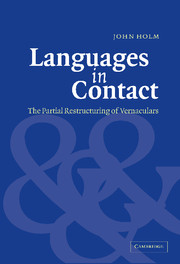5 - The structure of clauses
Published online by Cambridge University Press: 22 September 2009
Summary
Introduction
With the exception of Afrikaans, the partially restructured languages examined here have the subject-verb-object word order for declarative sentences that is found in both their Western European superstrate and Niger-Congo substrate. In fact, this is also the basic word order in all of the Atlantic creoles. Brazilian Vernacular Portuguese favors the SVO order even for object pronouns, where European Portuguese can have SOV order. Afrikaans is unlike the other varieties in that it has basic SOV word order, but it is like them in so far as it follows the word order of its superstrate, Dutch, which coincides with the SOV order of some of Afrikaans' substrate languages.
While the European lexical source languages can require the inversion of the subject and the verb (or auxiliary) to transform a statement into a question, this is not a part of the syntax of Niger-Congo languages or full-fledged creoles. Instances of creole-like non-inversion of subject and verb (or auxiliary) that would be unacceptable in the source language can occur freely in all of the partially restructured varieties under discussion except Afrikaans, which adheres strictly to Dutch word order.
The structure of AAE clauses
AAE word order
African American English has the usual English subject-auxiliary inversion (or lack of it) in questions that can be answered “yes” or “no,” e.g. “Can I go?” (Burling 1973:68).
- Type
- Chapter
- Information
- Languages in ContactThe Partial Restructuring of Vernaculars, pp. 116 - 134Publisher: Cambridge University PressPrint publication year: 2003



